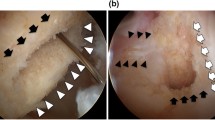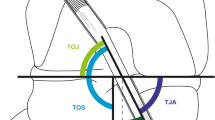Abstract
Purpose
The purpose of this study was to prospectively evaluate the clinical outcomes following anatomical rectangular tunnel anterior cruciate ligament (ACL) reconstruction with a bone–patellar tendon–bone (BTB) graft using an adjustable-length femoral cortical fixation device with enough patients and a high follow-up rate.
Methods
This study included 125 patients who underwent anatomical rectangular tunnel ACL reconstruction with a BTB graft. A BTB TightRope® was used for femoral graft fixation. Clinical evaluations were performed more than 2 years after surgery using the International Knee Documentation Committee (IKDC) Form. Patients interviewed by telephone were only subjectively evaluated. The side-to-side difference in anterior laxity at a manual maximum force was measured using the KT-2000 Arthrometer®.
Results
Among the 125 patients, 99 were ultimately included and 26 were lost to follow-up (follow-up rate: 79%). Eight patients had re-tear (re-tear rate: 8%) and six patients had ACL injuries to the contralateral knee. Three patients did not follow our rehabilitation programme. One patient suffered septic arthritis. These 18 patients were considered ineligible for clinical evaluations. Therefore, clinical evaluations were performed in 81 of the 99 patients (64 were available for direct follow-up and 17 were available for a telephone interview). The follow-up period was 30 ± 10 months (range 24–68 months). According to the IKDC subjective assessment, 48 (59%) and 33 (41%) knees were graded as normal and nearly normal, respectively. A loss of extension (3°–5°) was observed in five patients (8%), whereas one patient (2%) exhibited a loss of flexion (3°–5°). The Lachman test was negative in 63 patients (98%). The pivot shift test was negative in 59 patients (92%). The side-to-side difference in KT value was 0.4 ± 0.7 mm (range − 1–4 mm).
Conclusion
Anatomical rectangular tunnel ACL reconstruction with a BTB graft using an adjustable-length femoral cortical fixation device provided excellent clinical outcomes both subjectively and objectively more than 2 years after surgery, whereas 8 of the 99 patients had re-tear of the graft. The adjustable-length femoral cortical fixation device could be safely used in anatomical rectangular tunnel ACL reconstruction with a BTB graft.
Level of evidence
III
Similar content being viewed by others
Abbreviations
- ACL:
-
Anterior cruciate ligament
- HT:
-
Hamstring tendon
- BTB:
-
Bone–patellar tendon–bone
- CT:
-
Computed tomography
- ART:
-
Anatomical rectangular tunnel
- β-TCP:
-
Beta-tricalcium phosphate
- IKDC:
-
International Knee Documentation Committee
- R/R:
-
Recurrent abnormal laxity following a traumatic episode or reinjury
References
Ahn HW, Seon JK, Song EK, Park CJ, Lim HA (2019) Comparison of clinical and radiologic outcomes and second-look arthroscopic findings after anterior cruciate ligament reconstruction using fixed and adjustable loop cortical suspension devices. Arthroscopy 35:1736–1742
Amano H, Toritsuka Y, Uchida R, Mae T, Ohzono K, Shino K (2015) Outcome of anatomical double-bundle ACL reconstruction using hamstring tendons via an outside-in approach. Knee Surg Sports Traumatol Arthrosc 23:1222–1230
Barrow AE, Pilia M, Guda T, Kadrmas WR, Burns TC (2014) Femoral suspension devices for anterior cruciate ligament reconstruction: do adjustable loops lengthen? Am J Sports Med 42:343–349
Beynnon BD, Johnson RJ, Abate JA, Fleming BC, Nichols CE (2005) Treatment of anterior cruciate ligament injuries, part 2. Am J Sports Med 33:1751–1767
Brand J Jr, Weiler A, Caborn DN, Brown CH Jr, Johnson DL (2000) Graft fixation in cruciate ligament reconstruction. Am J Sports Med 28:761–774
Bressy G, Brun V, Ferrier A, Dujardin D, Oubaya N, Morel N, Fontanin N, Ohl X (2016) Lack of stability at more than 12 months of follow-up after anterior cruciate ligament reconstruction using all-inside quadruple-stranded semitendinosus graft with adjustable cortical button fixation in both femoral and tibial sides. Orthop Traumatol Surg Res 102:867–872
Chen W, Li H, Chen Y, Jiang F, Wu Y, Chen S (2019) Bone-patellar tendon-bone autografts versus hamstring autografts using the same suspensory fixations in ACL reconstruction: a systematic review and meta-analysis. Orthop J Sports Med 7:2325967119885314
Choi NH, Yang BS, Victoroff BN (2017) Clinical and radiological outcomes after hamstring anterior cruciate ligament reconstructions: comparison between fixed-loop and adjustable-loop cortical suspension devices. Am J Sports Med 45:826–831
Choi NH, Park TH, Oh WK, Victoroff BN (2019) Radiologic and clinical outcomes after hamstring anterior cruciate ligament reconstruction using an adjustable-loop cortical suspension device with retensioning and knot tying. Arthroscopy 35:2629–2633
Colombet P, Saffarini M, Bouguennec N (2018) Clinical and functional outcomes of anterior cruciate ligament reconstruction at a minimum of 2 years using adjustable suspensory fixation in both the femur and tibia: a prospective study. Orthop J Sports Med 6:2325967118804128
Delaloye JR, Murar J, Vieira TD, Franck F, Pioger C, Helfer L, Saithna A, Sonnery-Cottet B (2020) Knee extension deficit in the early postoperative period predisposes to cyclops syndrome after anterior cruciate ligament reconstruction: a risk factor analysis in 3633 patients from the SANTI Study Group database. Am J Sports Med 48:565–572
Dworsky BD, Jewell BF, Bach BR Jr (1996) Interference screw divergence in endoscopic anterior cruciate ligament reconstruction. Arthroscopy 12:45–49
Eguchi A, Ochi M, Adachi N, Deie M, Nakamae A, Usman MA (2014) Mechanical properties of suspensory fixation devices for anterior cruciate ligament reconstruction: comparison of the fixed-length loop device versus the adjustable-length loop device. Knee 21:743–748
Glasbrenner J, Domnick C, Raschke MJ, Willinghöfer T, Kittl C, Michel P, Wähnert D, Herbort M (2019) Adjustable buttons for ACL graft cortical fixation partially fail with cyclic loading and unloading. Knee Surg Sports Traumatol Arthrosc 27:2530–2536
Hutchinson MR, Ash SA (2003) Resident’s ridge: assessing the cortical thickness of the lateral wall and roof of the intercondylar notch. Arthroscopy 19:931–935
Johnson JS, Smith SD, LaPrade CM, Turnbull TL, LaPrade RF, Wijdicks CA (2015) A biomechanical comparison of femoral cortical suspension devices for soft tissue anterior cruciate ligament reconstruction under high loads. Am J Sports Med 43:154–160
Iwahashi T, Shino K, Nakata K, Otsubo H, Suzuki T, Amano H, Nakamura N (2010) Direct anterior cruciate ligament insertion to the femur assessed by histology and 3-dimensional volume-rendered computed tomography. Arthroscopy 26:S13–S20
Karlakki SL, Downes ME (2003) Intra-articular migration of femoral interference screw: open or arthroscopic removal. Arthroscopy 19:E19
Kurosaka M, Yoshiya S, Andrish JT (1987) A biomechanical comparison of different surgical techniques of graft fixation in anterior cruciate ligament reconstruction. Am J Sports Med 15:225–229
Kusano M, Yonetani Y, Mae T, Nakata K, Yoshikawa H, Shino K (2017) Tibial insertions of the anterior cruciate ligament and the anterior horn of the lateral meniscus: a histological and computed tomographic study. Knee 24:782–791
Kusano M, Kazui A, Uchida R, Mae T, Tsuda T, Toritsuka Y (2018) Loop length change of an adjustable-length femoral cortical suspension device in anatomic rectangular tunnel anterior cruciate ligament reconstruction with a bone-patellar tendon-bone graft and associated clinical outcomes. Arthroscopy 34:3063–3070
Mae T, Shino K, Nakata K, Toritsuka Y, Otsubo H, Fujie H (2008) Optimization of graft fixation at the time of anterior cruciate ligament reconstruction. Part I: effect of initial tension. Am J Sports Med 36:1087–1093
Ohori T, Mae T, Shino K, Tachibana Y, Yoshikawa H, Nakata K (2019) Tibial tunnel enlargement after anatomic anterior cruciate ligament reconstruction with a bone-patellar tendon-bone graft. Part 1: Morphological change in the tibial tunnel. J Orthop Sci 24:861–866
Okimura S, Shino K, Nakagawa S, Iuchi R, Take Y, Mae T (2020) Minimal tibial tunnel enlargement after anatomic rectangular tunnel anterior cruciate ligament reconstruction with bone-patellar tendon-bone graft. J Orthop Sci 25:635–639
Petre BM, Smith SD, Jansson KS, de Meijer PP, Hackett TR, LaPrade RF, Wijdicks CA (2013) Femoral cortical suspension devices for soft tissue anterior cruciate ligament reconstruction: a comparative biomechanical study. Am J Sports Med 41:416–422
Putnis S, Neri T, Grasso S, Linklater J, Fritsch B, Parker D (2020) ACL hamstring grafts fixed using adjustable cortical suspension in both the femur and tibia demonstrate healing and integration on MRI at one year. Knee Surg Sports Traumatol Arthrosc 28:906–914
Rosenberg TD, Paulos LE, Parker RD, Coward DB, Scott SM (1988) The forty-five-degree posteroanterior flexion weight-bearing radiograph of the knee. J Bone Joint Surg Am 70:1479–1483
Shino K, Mae T, Maeda A, Miyama T, Shinjo H, Kawakami H (2002) Graft fixation with predetermined tension using a new device, the double spike plate. Arthroscopy 18:908–911
Shino K, Nakata K, Nakamura N, Toritsuka Y, Horibe S, Nakagawa S, Suzuki T (2008) Rectangular tunnel double-bundle anterior cruciate ligament reconstruction with bone-patellar tendon-bone graft to mimic natural fiber arrangement. Arthroscopy 24:1178–1183
Shino K, Suzuki T, Iwahashi T, Mae T, Nakamura N, Nakata K, Nakagawa S (2010) The resident’s ridge as an arthroscopic landmark for anatomical femoral tunnel drilling in ACL reconstruction. Knee Surg Sports Traumatol Arthrosc 18:1164–1168
Shino K, Mae T, Tachibana Y (2015) Anatomic ACL reconstruction: rectangular tunnel/bone-patellar tendon-bone or triple-bundle/semitendinosus tendon grafting. J Orthop Sci 20:457–468
Singh S, Ramos-Pascual S, Czerbak K, Malik M, Schranz PJ, Miles AW, Mandalia V (2020) Biomechanical testing of fixed and adjustable femoral cortical suspension devices for ACL reconstruction under high loads and extended cyclic loading. J Exp Orthop 7:27
Suzuki T, Shino K, Otsubo H, Suzuki D, Mae T, Fujimiya M, Yamashita T, Fujie H (2014) Biomechanical comparison between the rectangular-tunnel and the round-tunnel anterior cruciate ligament reconstruction procedures with a bone-patellar tendon-bone graft. Arthroscopy 30:1294–1302
Tachibana Y, Shino K, Mae T, Iuchi R, Take Y, Nakagawa S (2019) Anatomical rectangular tunnels identified with the arthroscopic landmarks result in excellent outcomes in ACL reconstruction with a BTB graft. Knee Surg Sports Traumatol Arthrosc 27:2680–2690
Toritsuka Y, Amano H, Yamada Y, Hamada M, Mitsuoka T, Horibe S, Shino K (2007) Bi-socket ACL reconstruction using hamstring tendons: high versus low femoral socket placement. Knee Surg Sports Traumatol Arthrosc 15:835–846
Toritsuka Y, Amano H, Kuwano M, Iwai T, Mae T, Ohzono K, Shino K (2009) Outcome of double-bundle ACL reconstruction using hamstring tendons. Knee Surg Sports Traumatol Arthrosc 17:456–463
Uchida R, Nakamura N, Suzuki T, Kusano M, Mae T, Ohzono K, Toritsuka Y (2019) Excellent bone plug–socket integration at 8 weeks after anterior cruciate ligament reconstruction using an adjustable-length loop cortical fixation device. J ISAKOS 4:9–14
Yonetani Y, Kusano M, Tsujii A, Kinugasa K, Hamada M, Shino K (2019) Tibial insertion of the anterior cruciate ligament and anterior horn of the lateral meniscus share the lateral slope of the medial intercondylar ridge: a computed tomography study in a young, healthy population. Knee 26:612–618
Funding
The authors received no financial support for the research, authorship, and/or publication of this article.
Author information
Authors and Affiliations
Contributions
TM designed the study and drafted the manuscript. YT was responsible for the revision of the manuscript. MK, RU, and TT assisted TM in analyzing the data. All authors approved the final manuscript.
Corresponding author
Ethics declarations
Conflict of interest
The authors declare that they have no conflict of interest.
Ethical approval
The Ethical Review Board of Kansai Rosai Hospital has approved this study (no. 12-10).
Informed consent
All patients provided informed consent before participation.
Additional information
Publisher's Note
Springer Nature remains neutral with regard to jurisdictional claims in published maps and institutional affiliations.
Rights and permissions
About this article
Cite this article
Matsuo, T., Kusano, M., Uchida, R. et al. Anatomical rectangular tunnel anterior cruciate ligament reconstruction provides excellent clinical outcomes. Knee Surg Sports Traumatol Arthrosc 30, 1396–1403 (2022). https://doi.org/10.1007/s00167-021-06609-5
Received:
Accepted:
Published:
Issue Date:
DOI: https://doi.org/10.1007/s00167-021-06609-5




